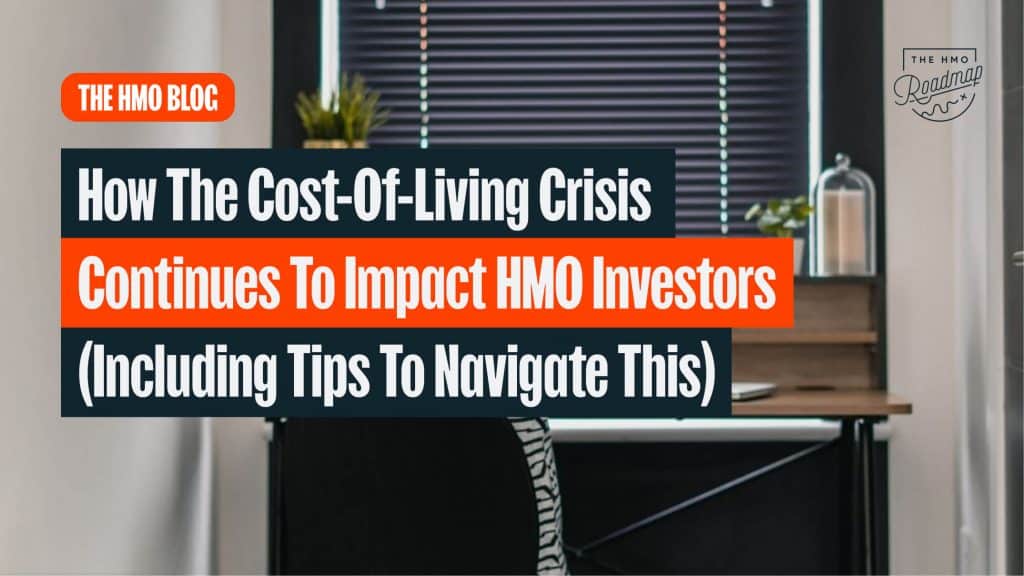
Photo by MW Property Investors
The cost-of-living crisis continues to put a strain on the UK as a whole. Rising energy bills and interest rates, in addition to the cost of so many other things, are naturally impacting people’s finances as inflation continues to hit high levels.
In this blog post, we’ll look at the current economic picture, the outlook for the future, how this will continue to impact HMO investors, and tips for navigating these challenges and the uncertainty that comes with the cost-of-living crisis!
The Cost-of-Living Crisis
Currently, the annual inflation rate sits at a 40-year high. In September, inflation increased to 10.1%, returning to double digits after a slight dip, according to the Office for National Statistics. Housing, energy, and water costs have seen the most substantial increase in the past year.
An increase in the cost of energy was the primary catalyst for the ongoing cost-of-living crisis. Ofgem had announced that the latest energy price cap would increase the average household bills to £3,549 on 1 October 2022. This was a jump of 80%, but emergency legislation has now superseded this rise.
The new energy price guarantee will ensure the typical household will pay £2,500 on average. While this was welcome news as it is about £1,000 less than what the new energy price cap was going to be. However, this is still higher than the price cap that came into effect in April 2022, which increased the average household energy bill to £1,971 per year.
Originally, this support was planned for the next two years; however, the new Chancellor, Jeremey Hunt, has scaled this down to six months. The support will be reviewed from April 2023, so it’s hard to know what will happen to energy bills then. This will certainly cause some further uncertainty!
How This Impacts HMO Investors
With the cost-of-living crisis, HMO landlords’ costs are naturally going up like everyone else’s. From energy bills and other household bills to labour and material costs, there are so many things we need to factor in at the moment!
Additionally, amid the turbulent economy and uncertainty, interest rates have also increased, pushing mortgage rates further. On 3 November, the Bank of England raised the base interest rate 0.75% to a 33-year high of 3%. This is the eighth consecutive increase to the base rate and is the single largest rise since 1989.
This will make borrowing even more expensive. With continuing uncertainty in the mortgage market, more property transactions will fall through. And as lenders are increasing affordability stress tests as well, this will likely lead to more people being rejected for mortgage offers or being asked for larger deposits.
The Bank of England is also warning that the UK is already in a recession and that this could be the longest recession on record. The cost-of-living crisis, stagnating economy, and landscape of the mortgage market all directly impact what we’ll be able to borrow, our operating costs, and what we can earn from our investments.
3 Tips for Navigating the Cost-of-Living Crisis
As the cost-of-living crisis is expected to last well into 2023, we need to figure out how to best navigate these challenges. Here are a few helpful tips for HMOs investors!
- Invest in Energy Efficient Improvements
While it’s only a legal requirement to have an EPC rating of E or above for privately rented accommodation, there are plans for this to be pushed up to a C rating or higher. That could come into effect as early as 2025.
Making energy-efficient improvements to your HMOs comes with an initial cost to consider, but these kinds of changes could provide additional savings in the long term and also ensure you’re compliant in the future.
I believe that anything you can do to help manage energy costs is going to be a useful and probably profitable thing to do. Making these changes sooner could increase the demand for your properties as tenants look for more energy-efficient properties.
Note: There are grants and schemes that you might be eligible for to help fund your energy-efficient improvements.
- Ask Tenants for Guarantors
Rent arrears are naturally a top concern for landlords, especially so due to the cost-of-living crisis. This can be a black hole, costing thousands and thousands of pounds. According to the HomeLet Rental Index, 78% of tenants are worried about how they will pay rent.
But this is where guarantors can come into play! Requiring tenants to have guarantors can take away some of the financial pressure and help protect your HMOs. With my own HMO business, we require anyone who wants to live in our properties to have a UK-based guarantor.
- Reassess Rising Costs
Of course, you’ll need to factor in rising costs into your deal analysis moving forward, but you also need to consider all of your operating costs and check if there are opportunities for you to save on any of your bills.
Look at the length of your utility contracts and keep an eye out for any offers or better deals. This can help you and your tenants save extra cash where possible, which is especially important for everyone throughout the cost-of-living crisis.
If you’d like to talk about the challenges the rising cost of living and economic uncertainty presents with other experienced HMO investors, join our free Facebook Group The HMO Community, which now has more than 5,000 members! And to start, scale, and systemise your HMO portfolio, become a member of The HMO Roadmap today.

About the Author:
Andy Graham is the founder and the lead trainer at The HMO Roadmap! He is also the co-founder of The HMO Mastermind and Smart Property, a specialist HMO property investment and management company. He writes as a regular columnist in different magazines about a variety of HMO topics and is the host of The HMO Podcast! Follow Andy on Instagram!